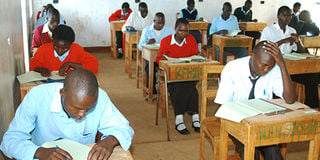Students with lower grades to join university

Students siitting for a past national examination. Dons meeting on Monday will look at how students performed in the Kenya Certificate of Secondary Education (KCSE) examinations in 2008. Photo/DENNIS OKEYO
Public universities will on Monday agree to admit high school graduates with lower marks compared to last year, according to Nation estimates.
The universities will set the minimum score for admission at a B Plain of between 65 and 66 points. The Nation estimate is based on the same criteria used by the Joint Admissions Board, the committee of top dons which is charged with setting admission policy for the seven public universities.
The dons, meeting on Monday at Maseno University, will look at how students performed in the Kenya Certificate of Secondary Education (KCSE) examinations in 2008, the beds (and lecture halls) available at various campuses and the number of students the government is willing to sponsor.
Regular programme
The regular programme at public universities is funded by the exchequer. Students locked out of that programme can still join the universities, but they will have to pay their own fees.
A loan scheme is administered by the Higher Education Loans Board. Based on those factors, JAB should admit about 18,000 out of the 72,500 who scored a mean grade of C+ or better, the minimum grade for joining university in Kenya.
This effectively locks out about 50,000 candidates who qualified. Some 304,995 high school students sat the exam.
Since the places available in the regular programmes are limited — and the fact that the government cannot sponsor all qualifiers — the JAB will this morning set the cut-off point of entry.
The cut-off point is likely to be lower because last year students did not perform as well as the previous year, when 82,000 students scored a mean grade of C+ and above. Universities have also increased colleges and campuses and hence the bed and lecture hall capacity.
New record
This year’s expected selection will be a new record in the 20-year history of the 8-4-4 system. It will be higher than the 16,629 admitted from the candidates who sat the 2007 KCSE. The maximum a candidate can score in the exams is an A of 84 points.
Scoring 66 points represents the highest point a candidate can score to obtain a mean grade of B plain. With 65 points, the other likely cut-off point, a candidate also obtains a B plain.
For the 2007 KCSE lot, the cut-off point was 66 points, although women were admitted at two points lower. In 2006, the cut-off point was 67 for men and 66 for women, one of the highest.
Students are competing for places in the universities of Nairobi, Moi, Kenyatta, Egerton, Jomo Kenyatta, Maseno and Masinde Muliro. The universities have more than 10 constituent colleges.
JAB secretary Ben Waweru said the meeting takes place today but could not give more details about the cut-off point or the number of students each university is able to absorb. The board is chaired by University of Nairobi vice chancellor Prof George Magoha.
“If candidates performed better than the previous year, the cut-off point can be higher,” he said. Mr Waweru said he expected the board to retain its policy of affirmative action, which allows women candidates to join universities at a point below the men.
Another group of students given the benefit of affirmative action are those from arid areas, who study under difficult circumstances.
Monday’s meeting marks the start of the admission process, which will be concluded in January. Successful applicants will report to universities next year.
According to the 2008 admission figures, which are expected to mirror this year’s, the University of Nairobi accommodated the highest number of new students at 3,905.
Moi University took in 3,270 while Kenyatta admitted 3,128. Others were Egerton (1,924), JKUAT (1,159) and Maseno (897). Kakamega-based Masinde Muliro absorbed 506.




